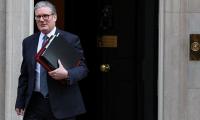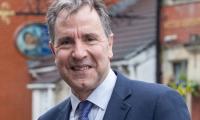Keynesian economics dominated economic theory and policy after the Second World War until the mid-1970s. Neoliberal economists launched a vicious attack on state intervention in the economy and the social welfare model. They used both inflation and slow growth – a situation called stagflation – that developed in many advanced economies to undermine the usefulness of Keynesian policies.
Keynesian theory’s popularity waned because it had no appropriate policy response for stagflation. Neoliberal economists, ideologues, politicians and experts used that opportunity to discredit the Keynesian economic model and the public-sector-led model of growth and economic development.
The Keynesian economic model is an economic theory based on the work of British economist John Maynard Keynes in the 1930s. Keynes believed in capitalism, but deviated from the free-market, liberal economic model of the pre-First World War era. He suggested that government intervention can be used to moderate the business cycle and promote economic growth. The Keynesian model focuses on aggregate demand – the total amount of goods and services bought in an economy – as the primary driving force in an economy.
John Maynard Keynes’s work argues for a mixed economy with governmental intervention in the form of fiscal and monetary policies. It advocates government spending to stimulate economies and lower unemployment, and the use of monetary policy to manage the money supply and maintain price stability. It also argues for an international monetary system that will stabilize exchange rates and promote free trade.
The theory suggests that if aggregate demand is low, the government can increase it through fiscal policy, such as spending on public-work projects, cutting taxes, or increasing the money supply. Conversely, if aggregate demand is high, the government can reduce it through fiscal policy, such as cutting spending, raising taxes, or reducing the money supply. The aim of the Keynesian model is to achieve a balance between aggregate demand and aggregate supply to achieve full employment and stable prices.
Keynesian economic policies tend to involve more government intervention in the economy, such as increased spending and taxes on the rich. This can be seen as a threat to the economic interests of the ruling elite, who may be concerned that their wealth and power will be diminished if these policies are implemented.
If implemented today, Keynesian economic policies can help reduce inequality and provide some human face to reckless capitalism. Keynesian policies, such as government spending and tax cuts, can increase demand and create jobs, which can help reduce inequality by raising wages and creating more opportunities for people of all incomes. Additionally, government policies can be used to increase the minimum wage, provide more employment benefits and make the tax system more progressive, which can help reduce inequality.
But the ruling elites around the world are fiercely resisting any big change in the neoliberal economic policies. The elites are ready to go to any extent to defend their economic, social and political interests at the cost of the working and middle classes. Any deviation from the neoliberal economic order is considered as a serious crime and needs to be punished.
On the basis of the neoliberal order, the elites amass unprecedented wealth and political power. They are not ready to give up even a small chunk of their wealth and power, despite the fact that the working class and the poor around the world are drowned in a sea of poverty, unemployment, hunger and price hikes.
There were expectations that after the Great Recession of 2007-08 and the apparent failure of the neoliberal free market economic order, the world would return to Keynesianism. But it didn’t happen. The main reason was the domination of the neoliberal capitalist ideology. Neoliberal economists had – and still have – control over key state organs. The IMF, World Bank, WTO and other international financial institutions were – and are still – in the grip of the neoliberal ideology.
Governments in the US, Europe and other countries took some Keynesian measures to bail out banks and big business. The state intervened to avoid a bigger collapse of the economy and help the private sector sail through troubled waters. Trillions of dollars of taxpayers’ money was spent to rescue big business and billionaires. But Keynesian policies were also partially adopted for the time being to help the super-rich and some sections of the poor.
The global financial crisis of 2007–08 caused a resurgence in Keynesian thought. It was the theoretical underpinnings of economic policies in response to the crisis by many governments, including in the US and the UK.
Many economists wrote dozens of excellent books, explaining Keynesian economic policies and offering proposals to solve the economic crisis. But the elites fiercely resisted any attempt to re-introduce the mix-economy based on the Keynesian theory.
Even though I personally believe that the real alternative to capitalism is socialism, a mixed economy with both socialist and capitalist elements – with the dominance of socialist aspects – could be a viable alternative to blind market forces and neoliberalism. Such an economy could solve the basic needs of the working class and rebuild the national economy.
But even from a more rational capitalist point of view, the neoliberal project has gone too far and outlived its utility. The neoliberal political and economic order is fast developing such conditions in which the working class and poor populations will be left with no other option than to rebel against this dominating capitalist ideology. The current situation is likely to lead to social explosions from the below. This situation cannot be sustained for long.
At the moment, the elites are not facing big resistance from the below. But anger is brewing. It can erupt like a volcano in the coming months. In such an explosive situation, the elites might be forced to adopt Keynesian policies like they did during the post-Second World War era.
The writer is a freelance journalist.
Beijing was among first to denounce the tariffs, calling them “unjustifiable” and vowing strong countermeasures
With this unprecedented buildup, Diego Garcia has transformed into ticking time bomb of apocalyptic power
Pakistan is among world’s most climate-vulnerable nations, despite contributing minimally to global emissions
‘Azazeel’ is perhaps the most controversial novel to come out in Egypt this century
Dr Haroon Ahmed was an exceptional person, a precious human being who strived, throughout his long life
Pakistan can't afford another status quo budget so it must be budget of imagination, risk-taking and system-level...







